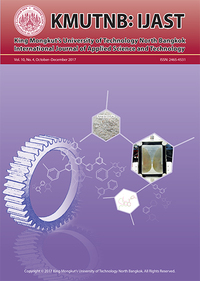Warehouse Performance Measurement: Structural Equation Modeling Technique and PEST Analysis
Main Article Content
Abstract
This research aims to propose a new model for warehouse performance measurement by overcoming the limitations of the traditional technique called productivity ratio. The proposed model is built up from 215 warehouses with Structural Equation Modeling (SEM) technique. This research focuses on exploring the relationships among four warehouse performance indicators. The indicators are classified and grouped according to the dimensions of time, cost, productivity and quality. In order to maintain consistency among metrics from different warehouse areas, a standard warehouse is defined according to layout, activities and indicators measurement units. Finally, the proposed model can help manufacturing firms to know the firm warehouse performance. This research also analyzes the effects of external factors on warehouse performance. Political, economic, social, and technological factors, called PEST, are used as an analytical framework. After that the PEST analysis is applied with the proposed model the results found that the technological factor has the highest impact on warehouse performance. The economic factors are the next level of impact assessment. The last two factors are social and political issue, could be the least significant.
Article Details
References
[2] C. Poompipatpong, A. Kengpol, and T. Uthistham, “The effects of diesel-waste plastic oil blends on engine performance characteristics,” KMUTNB Int J Appl Sci Technol, vol. 7, no. 1, pp. 37–45, 2014.
[3] K. Kardono, “Environmental performance test of hazardous waste incinerator in Indonesia,” KMUTNB Int J Appl Sci Technol, vol. 9, no. 2, pp. 79–90, 2016.
[4] F. Saleheen, “Challenges of warehouse operations: A case study in retail supermarket,” Supply Chain Managemen, vol. 3, no. 4, pp. 63–67, Dec. 2014.
[5] A. M. Atieh, H. Kaylani, Y. Al-abdallat, A. Qaderi, L. Ghoul, L. Jaradat, and I. Hdairis, “Performance improvement of inventory management system processes by an automated warehouse management system,” Procedia CIRP, vol. 41, pp. 568–572, 2016.
[6] P. Khemavuk and M. Hasan, “Warehouse performance measurement: Structural equation modeling technique and analogy based approach,” Logistics and Transport, vol. 3, no. 2, pp.57–73, Oct. 2010.
[7] F. H. Staudt, M. Di Mascolo, G. Alpan, and C.M.T. Rodriguez, “Warehouse performance measurement: Classification and mathematic expressions of indicators,” in Proceedings of the International Conference on Information Systems, Logistics and Supply Chain, Breda, Netherlands, 2014, pp. 1–9.
[8] A. Gunasekaran, H. B. Marri, and F. Menci, “Improving the effectiveness of warehousing operations: A case study” Industrial Management and Data Systems, vol. 99, no. 8, pp. 328–339, Aug. 1999.
[9] Z. Ezziane, “Evaluating customer service performance in warehousing environments,” Logistics Information Management, vol. 13, no. 2, pp. 90–94, Apr. 2000.
[10] A.W. Keifer and R. A. Novack, “An empirical analysis of warehouse measurement systems in the context of supply chain implementation,” Transportation Journal, vol. 38, no. 3, pp. 18–27, 1999.
[11] M. B. M. De Koster and P. M. J. Warffemius, “American, Asian, and Third-party international warehouse operations in Europe: A performance comparison,” International Journal of Operations and Production management, vol. 25, no. 8, pp. 762–780, Aug. 2005.
[12] F. Huq, D. A. Hensler, and R. Sabatier, “Simulation study of a two-level warehouse inventory replenishment system,” Physical Distribution and Logistics Management, vol. 36, no. 1, pp. 51–65, Jan. 2006.
[13] J. Gu, M. Goetschalckx and L.F. McGinnis, “Research on warehouse operation: A comprehensive review,”European Journal of Operational Research, vol. 177, no. 1, pp. 1–21, Feb. 2007.
[14] L. R. Yang and J. H. Chen, “Information systems utilization to improve distribution center performance: From the perspective of task characteristics and customers,” Advances in Information Sciences and Service Sciences, vol. 4, no. 1, pp. 230–238, Jan. 2012.
[15] J. T. Mentzer and B. P. Konrad, “An efficiency/effectiveness approach to logistics performance analysis,” Journal of Business Logistics, vol. 12, no. 1, pp. 33–61, Dec. 1991.
[16] I. Manikas and L. A. Terry, “A case study assessment of the operational performance of a multiple fresh produce distribution centre in the UK,” British Food Journal, vol. 112, no. 6, pp. 653–667, May 2010.
[17] R. De Koster, T. Le-Duc, and K. J. Roodbergen, “Design and control of warehouse order picking: A literature review,” European Journal of Operational Research, vol. 182, no. 2, pp. 481–501, Oct. 2007.
[18] M. Dotoli, M. P. Fanti, and G. Lacobellis, “Performance analysis and management of an automated distribution center,” in Proceedings 35th Annual Conference of IEEE Industrial Electronics, 2009, pp. 4371–4376.
[19] F. Gallmann and V. Belvedere, “Linking service level, inventory management and warehousing practices: A case-based managerial analysis,” Operations Management Research, vol. 4, no. 1–2, pp. 28–38, Jun. 2011.
[20] B. M. Beamon, “Measuring supply chain performance,” International Journal of Operations and Production Management, vol. 19, no. 3, pp. 275–292, Mar. 1999.
[21] J. S. Keebler and R. E. Plank, “Logistics performance measurement in the supply chain: A benchmark,” Benchmarking: An International Journal, vol. 16, no. 6, pp. 785–798, Oct. 2009.
[22] J. Tongzon, “Determinants of competitiveness in logistics: Implication for the region,” presented at the International Conference on Competitiveness: Challenges and Opportunities for Asian Countries, Bangkok, Thailand, 2004.
[23] A. Hirunwat and P. Khemavuk, “AHP analysis of PEST factors affecting warehouse performances,” presented at the 10th International Conference Logistics and SCM Systems, Chiang Mai, Thailand, July 1–4, 2015.
[24] D. Folinas and D. Aidonis, “The effects of economic crisis to logistics outsourcing,” Business Science and Applied Management, vol. 7, no. 3, pp. 56–67, 2012.


